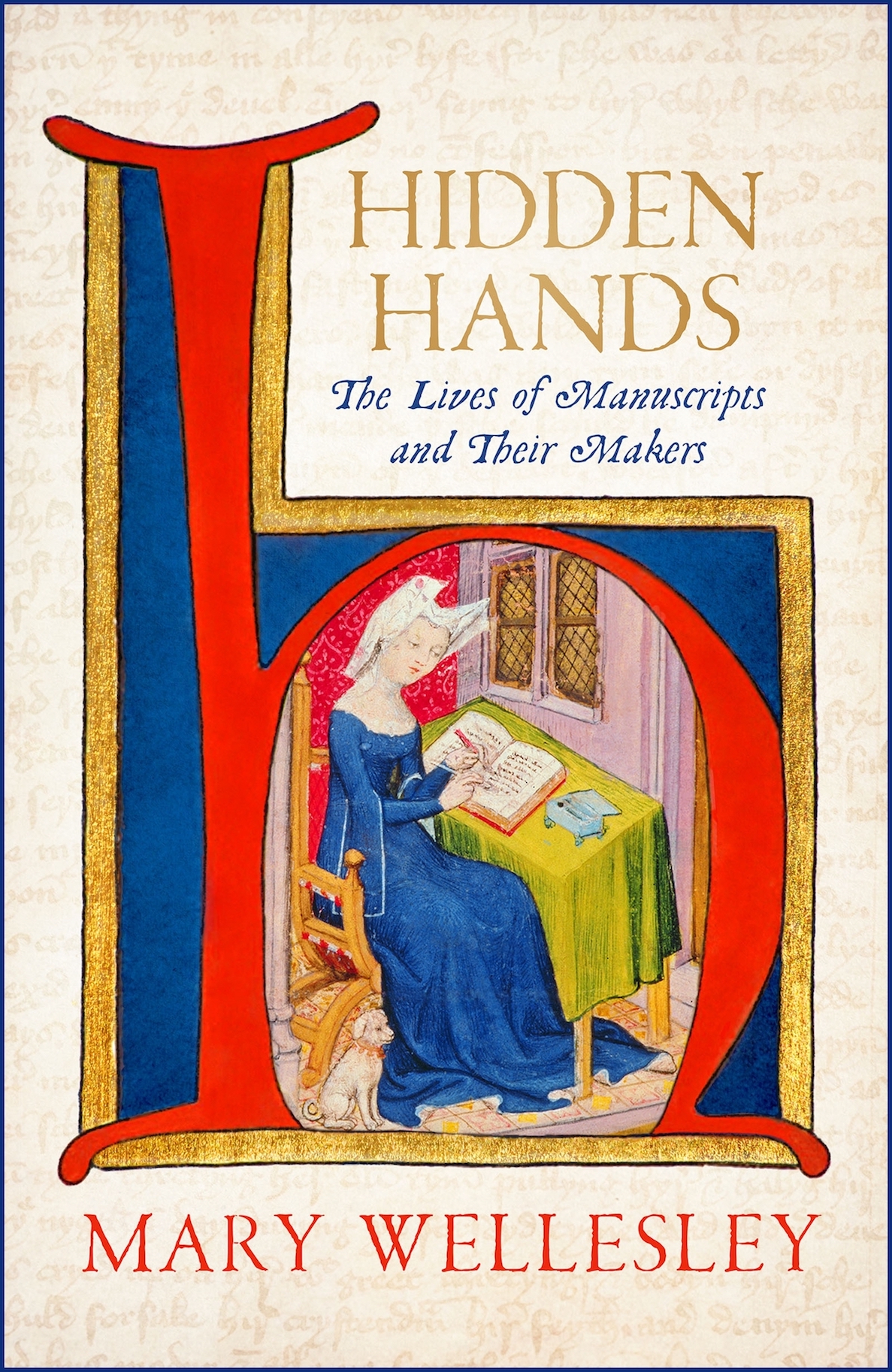Mary Wellesley: Hidden Hands review - passion in the parchment | reviews, news & interviews
Mary Wellesley: Hidden Hands review - passion in the parchment
Mary Wellesley: Hidden Hands review - passion in the parchment
Medieval manuscripts and their forgotten artist-authors come to life

Outside Wales – even, perhaps, within it – few students will have run across the verse of Gwerful Mechain.
Subtitled “the lives of manuscripts and their makers”, Hidden Hands not only shows how a variety of written works, both famous and forgotten, were created and transmitted in Britain over eight medieval centuries – between AD700 and 1500. Wellesley tracks the afterlives of her chosen texts. She demonstrates how accident, prejudice and power – “the whims of scribes, the biases of collectors and the vagaries of chance” – determined which works lived, and which died. In Gwerful Mechain’s case, the wealth of manuscript copies attests to her renown. Her verse went on circulating orally as well. Welsh Victorians, however, wanted to uphold Nonconformist piety and rebut English stereotypes about their wild ways. Gwerful’s defiant sensuality and frankness about women’s lives would hardly please the chapel elders. She dropped below the literary horizon, but – mercifully – never quite vanished. This book tells many such tales of “survival against the odds”.
Wellesley has worked in the British Library’s manuscript division and still teaches in its education programme. Hidden Hands, her debut, brims with a contagious enthusiasm about the ability of hand-crafted works from before the age of print to act as a “portal” into the world of their makers. A number of recent studies have brought seemingly dry medieval subjects to life with storytelling verve added to lightly-worn erudition. Hidden Hands neatly complements one in particular: Christopher de Hamel’s much-loved Meetings with Remarkable Manuscripts. Wellesley casts her net wider over medieval life and literature in a more informal, even digressive, but still thoroughly learned style. She places a special stress on the faint marks left by women authors, scribes and artists. This quest to encounter “the ghosts of those we have lost” situates her in a great tradition of female (indeed feminist) medievalists. It began with pioneers such as Helen Waddell, Eileen Power and even Dorothy L Sayers – who translated Dante as well as inventing the toff sleuth Lord Peter Wimsey.
If you find fixed canons and rigid orthodoxies off-putting, then medieval manuscripts might, paradoxically, suit you. So much remains fluid and open to debate: who commissioned, designed and wrote what; how individual works came into being; the relations of patron, author and scribe (or illuminator) – even the genre to which texts belong. Many volumes, as Hidden Hands explains, take the form of loose miscellanies. Pious tracts, poems, pictures, stray annotations, jokes and riddles, all jostle on the decorated page. Wellesley makes a fine advocate for the messy, multiform complexity of the hand-lettered manuscript – with its marginalia, over-writings and erasures – as opposed to “the sanitised, ordered blandness of the modern, printed text”. Besides, Hidden Hands never loses touch with the grainy materiality of medieval literary production. Wellesley gets her own hands dirty in Britain’s only surviving parchment works, which smells “like the inside of a boxing glove”. She delves into the chemical analysis of page and ink that can save the memory of unnamed scribe and artist from oblivion. Hence the teeth of an 11th-century German nun, with tiny crystals of lapis lazuli left from licking a paintbrush, indicate that women did work as manuscript illuminators, “and with the most precious materials in the trade”.
Manufacture of lavish manuscripts could take almost as long as building the abbeys and cathedrals that housed them. Hidden Hands details the long-haul, sub-contracted labour that saw a small army of specialists collaborate on the magnificent 12th-century Winchester Bible, whose format “allows us to lift the bonnet and see the workings of the artistic engine”. Wellesley also tries to recover the names and the stories of long-departed book-creators. We meet, for instance, the nun Leoba, taught to write verse by the Abbess of Thanet and “the first named English female poet”; or Hugeberc, a missionary sister from England who, around 780, left cleverly coded traces of her presence in a German work of hagiography; and Bishop Eadfrith, who – for once – can be securely identified as the chief artist-scribe who crafted the Lindisfarne Gospels half a century earlier.
 Eadfrith managed to dodge the anonymity that has buried most of the craftspeople, women and men, commemorated in Hidden Hands. With the “comedic and surreal” illuminators who filled the margins of the 14th-century Luttrell Psalter with medieval sitcom scenes, “strange events and outlandish beasts”, in addition to lovingly inked sketches of everyday Lincolnshire life, we can only name them as “Hand B”, the “Luttrell Master”, and so on. So it comes a jolt to learn that two of the principal hands responsible for the mighty Sherborne Missal (c.1400) have names firmly attached to them: John Siferwas, the artist, and John Whas, the scribe.
Eadfrith managed to dodge the anonymity that has buried most of the craftspeople, women and men, commemorated in Hidden Hands. With the “comedic and surreal” illuminators who filled the margins of the 14th-century Luttrell Psalter with medieval sitcom scenes, “strange events and outlandish beasts”, in addition to lovingly inked sketches of everyday Lincolnshire life, we can only name them as “Hand B”, the “Luttrell Master”, and so on. So it comes a jolt to learn that two of the principal hands responsible for the mighty Sherborne Missal (c.1400) have names firmly attached to them: John Siferwas, the artist, and John Whas, the scribe.
Wellesley tells some relatively familiar stories as well as rescuing others from oblivion. She considers the famous Paston Letters from 15th-century Norfolk, and shows how their male scribes could get dangerously close to the women of substance who dictated them. She evokes the anchorite’s life of the mystic Julian of Norwich – that visionary thinker from a time when “one of the few ways women could achieve autonomy and social standing… was by imprisoning themselves”. And she surveys the 92 early manuscripts of Chaucer’s Canterbury Tales, which taken together look “as diverse, messy, surprising and delightful” as the pilgrims’ yarns themselves.
Gorgeously illustrated with plates from its star works, Hidden Hands covers much ground within a modest span. Its transitions – like a brief coda on the arrival of the printed book – can feel abrupt. Compared to De Hamel’s tight focus and chronological march, it shares something of the quick-change, vagabond feel of the manuscripts it presents, with their rapid switches of form and tone. Once or twice, crisper editing would have sharpened it: so Shakespeare’s autograph manuscript of pages of the play The Book of Sir Thomas More is introduced on p.267, and again on p.272. But none of that detracts from the infectious pleasure in discovery that animates each page with bustling life and unexpected depth of feeling. As “the centuries dissolve”, the women and men who made these artefacts step from the shadows. To reach Gwerful Mechain, Wellesley writes, “we have to search in the spaces between the lines”. Delightfully, Hidden Hands does exactly that.
- Hidden Hands: the Lives of Manuscripts and their Makers by Mary Wellesley (riverrun, £25)
- More book reviews and features on theartsdesk
The future of Arts Journalism
You can stop theartsdesk.com closing!
We urgently need financing to survive. Our fundraising drive has thus far raised £49,000 but we need to reach £100,000 or we will be forced to close. Please contribute here: https://gofund.me/c3f6033d
And if you can forward this information to anyone who might assist, we’d be grateful.

Subscribe to theartsdesk.com
Thank you for continuing to read our work on theartsdesk.com. For unlimited access to every article in its entirety, including our archive of more than 15,000 pieces, we're asking for £5 per month or £40 per year. We feel it's a very good deal, and hope you do too.
To take a subscription now simply click here.
And if you're looking for that extra gift for a friend or family member, why not treat them to a theartsdesk.com gift subscription?
more Books
 'We are bowled over!' Thank you for your messages of love and support
Much-appreciated words of commendation from readers and the cultural community
'We are bowled over!' Thank you for your messages of love and support
Much-appreciated words of commendation from readers and the cultural community
 Justin Lewis: Into the Groove review - fun and fact-filled trip through Eighties pop
Month by month journey through a decade gives insights into ordinary people’s lives
Justin Lewis: Into the Groove review - fun and fact-filled trip through Eighties pop
Month by month journey through a decade gives insights into ordinary people’s lives
 Joanna Pocock: Greyhound review - on the road again
A writer retraces her steps to furrow a deeper path through modern America
Joanna Pocock: Greyhound review - on the road again
A writer retraces her steps to furrow a deeper path through modern America
 Mark Hussey: Mrs Dalloway - Biography of a Novel review - echoes across crises
On the centenary of the work's publication an insightful book shows its prescience
Mark Hussey: Mrs Dalloway - Biography of a Novel review - echoes across crises
On the centenary of the work's publication an insightful book shows its prescience
 Frances Wilson: Electric Spark - The Enigma of Muriel Spark review - the matter of fact
Frances Wilson employs her full artistic power to keep pace with Spark’s fantastic and fugitive life
Frances Wilson: Electric Spark - The Enigma of Muriel Spark review - the matter of fact
Frances Wilson employs her full artistic power to keep pace with Spark’s fantastic and fugitive life
 Elizabeth Alker: Everything We Do is Music review - Prokofiev goes pop
A compelling journey into a surprising musical kinship
Elizabeth Alker: Everything We Do is Music review - Prokofiev goes pop
A compelling journey into a surprising musical kinship
 Natalia Ginzburg: The City and the House review - a dying art
Dick Davis renders this analogue love-letter in polyphonic English
Natalia Ginzburg: The City and the House review - a dying art
Dick Davis renders this analogue love-letter in polyphonic English
 Tom Raworth: Cancer review - truthfulness
A 'lost' book reconfirms Raworth’s legacy as one of the great lyric poets
Tom Raworth: Cancer review - truthfulness
A 'lost' book reconfirms Raworth’s legacy as one of the great lyric poets
 Ian Leslie: John and Paul - A Love Story in Songs review - help!
Ian Leslie loses himself in amateur psychology, and fatally misreads The Beatles
Ian Leslie: John and Paul - A Love Story in Songs review - help!
Ian Leslie loses himself in amateur psychology, and fatally misreads The Beatles
 Samuel Arbesman: The Magic of Code review - the spark ages
A wide-eyed take on our digital world can’t quite dispel the dangers
Samuel Arbesman: The Magic of Code review - the spark ages
A wide-eyed take on our digital world can’t quite dispel the dangers
 Zsuzsanna Gahse: Mountainish review - seeking refuge
Notes on danger and dialogue in the shadow of the Swiss Alps
Zsuzsanna Gahse: Mountainish review - seeking refuge
Notes on danger and dialogue in the shadow of the Swiss Alps
 Patrick McGilligan: Woody Allen - A Travesty of a Mockery of a Sham review - New York stories
Fair-minded Woody Allen biography covers all bases
Patrick McGilligan: Woody Allen - A Travesty of a Mockery of a Sham review - New York stories
Fair-minded Woody Allen biography covers all bases

Add comment